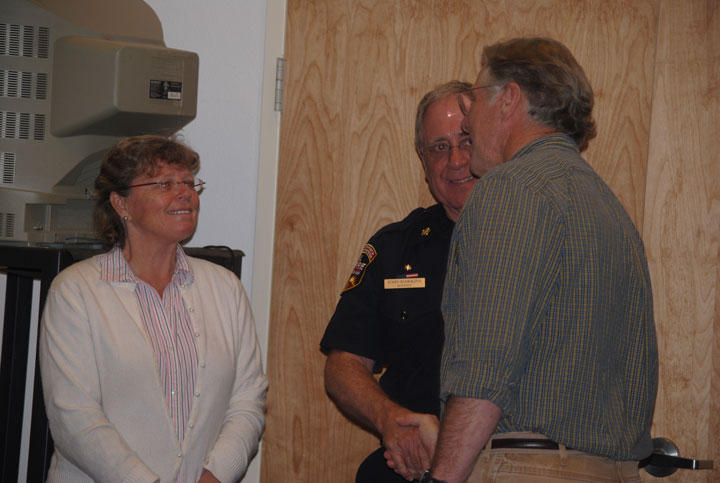Officials and community working to contain threats to oaks

Photo by J. P. Crumrine
“If [the Goldspotted oak borer problem] doesn’t get taken care of, it will devastate the oaks on the Hill,” said Chris Kramer, president of the Mountain Communities Fire Safe Council, as he opened the community meeting Saturday at the Nature Center.
The MCFSC invited experts from the University of California, Riverside, Cal Fire and the U.S. Forest Service to discuss the current condition of oaks on the Hill and status of the GSOB infestation here and in Southern California.
The number of infested trees remains at 62 this winter, but every speaker encouraged the audience to pay special attention to the black oaks as leaves begin to sprout and appear this spring.
Anyone observing small or dwarf leaves should call the GSOB hotline at 951-659-8328. Inspections can be arranged and the tree’s condition assessed and confirmed.
More volunteer inspectors are needed and Edwina Scott, MCFSC executive director, encourages people to sign up or call her office for more information 951-659-6208.
“Idyllwild is unique. A lot of people here care about the forest,” she said. “We need your help. Nobody knows the neighborhoods better than you.” GSOB volunteers are able and willing to educate and prepare new volunteers, she promised.
The GSOB is not native to Southern California and probably arrived in San Diego County in the mid-1990s, according to Dr. Tom Scott, University of California, Riverside. Since it is an invasive pest, it was not identified until 2008. Meanwhile, more than 65,000 Southern California acres have been devastated and more than 80,000 oak trees have died or been removed. Costs are in the millions.
In 2012, the GSOB was first identified in Idyllwild. The goal is to avoid what happened in San Diego County, Scott said. “One tree in Idyllwild had more than 5,000 beetles.”
“Only two positive trees have been identified in the last six months,” said Cal Fire Hill Forester Gregg Bratcher. “But I don’t believe the problem has been solved. The community must still be vigilant.” Infested trees have been identified throughout Idyllwild and some in Pine Cove.
Thus far, no infested trees have been discovered on U.S. Forest Service land on the Hill, said San Jacinto Ranger District Forester Kayanna Warren.
But each speaker emphasized that current drought conditions, which have stressed all the forest trees, do increase the vulnerability of oaks to GSOB attacks.
The rapid response of organizing community groups to look for it and experts, including Cal Fire, removing severely damaged trees have probably contributed to a limited effect on the Hill compared to San Diego County, said Kevin Turner, University of California, Riverside.
“We think we’re actually having an impact. We won’t know for several more years,” said Scott. “We have not seen any problems on the Hill similar to San Diego County.”
Normally, 400 to 500 beetles will emerge from an infested oak each year and it takes between two and three years for the damage, which the larvae created, to kill the tree. “So don’t wait until the tree dies to call for inspection or removal,” Scott stressed.
“I think if we keep working the way we have been, we won’t lose all the black oaks, but we can’t stop now,” Scott urged the group.
Riverside County 3rd District Supervisor Chuck Washington attended the meeting, too. Afterwards, he said, “Wow, our natural resources in this beautiful community are under attack. This raises so many red flags when the beetle threatens the quality of life of my constituents.”
As the session ended, Bratcher also advised the group to be aware of more pine trees succumbing to bark-beetle attacks. In the past two months, he has observed an increase in the number of dead or dying pines from the native bark beetle.
“This has also been accelerated due to the drought,” he added. “This is the fourth year that water has not been available for trees. Their safety relies on the production of sap from water to enable them to pitch out the beetles.”
Before ending, Turner also advised the group of a new pest that can kill sycamores and willows: the Polyphagous shot hole borer. While this beetle favors avocado trees — and local growers are very worried — it also will attack many other trees.
Consequently, transporting firewood harboring the PSHB may introduce it to the Hill. It is prevalent in the avocado orchards and people buying firewood should be cautious about introducing this pest to the Hill.


